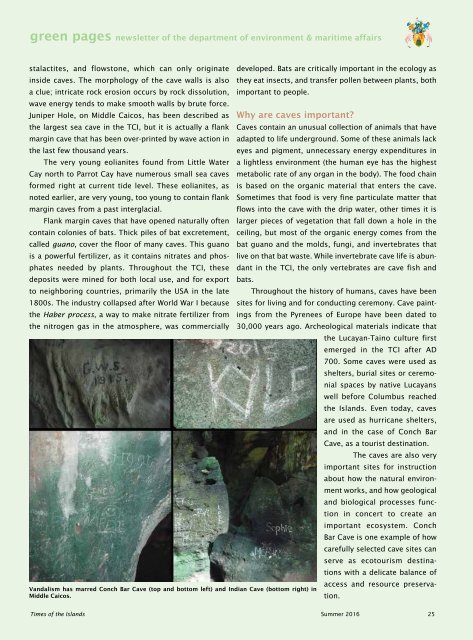Times of the Islands Summer 2016
Presents the "soul of the Turks & Caicos Islands" with in-depth features about local people, culture, history, environment, businesses, resorts, restaurants and activities.
Presents the "soul of the Turks & Caicos Islands" with in-depth features about local people, culture, history, environment, businesses, resorts, restaurants and activities.
You also want an ePaper? Increase the reach of your titles
YUMPU automatically turns print PDFs into web optimized ePapers that Google loves.
green pages newsletter <strong>of</strong> <strong>the</strong> department <strong>of</strong> environment & maritime affairs<br />
stalactites, and flowstone, which can only originate<br />
inside caves. The morphology <strong>of</strong> <strong>the</strong> cave walls is also<br />
a clue; intricate rock erosion occurs by rock dissolution,<br />
wave energy tends to make smooth walls by brute force.<br />
Juniper Hole, on Middle Caicos, has been described as<br />
<strong>the</strong> largest sea cave in <strong>the</strong> TCI, but it is actually a flank<br />
margin cave that has been over-printed by wave action in<br />
<strong>the</strong> last few thousand years.<br />
The very young eolianites found from Little Water<br />
Cay north to Parrot Cay have numerous small sea caves<br />
formed right at current tide level. These eolianites, as<br />
noted earlier, are very young, too young to contain flank<br />
margin caves from a past interglacial.<br />
Flank margin caves that have opened naturally <strong>of</strong>ten<br />
contain colonies <strong>of</strong> bats. Thick piles <strong>of</strong> bat excretement,<br />
called guano, cover <strong>the</strong> floor <strong>of</strong> many caves. This guano<br />
is a powerful fertilizer, as it contains nitrates and phosphates<br />
needed by plants. Throughout <strong>the</strong> TCI, <strong>the</strong>se<br />
deposits were mined for both local use, and for export<br />
to neighboring countries, primarily <strong>the</strong> USA in <strong>the</strong> late<br />
1800s. The industry collapsed after World War I because<br />
<strong>the</strong> Haber process, a way to make nitrate fertilizer from<br />
<strong>the</strong> nitrogen gas in <strong>the</strong> atmosphere, was commercially<br />
Vandalism has marred Conch Bar Cave (top and bottom left) and Indian Cave (bottom right) in<br />
Middle Caicos.<br />
developed. Bats are critically important in <strong>the</strong> ecology as<br />
<strong>the</strong>y eat insects, and transfer pollen between plants, both<br />
important to people.<br />
Why are caves important?<br />
Caves contain an unusual collection <strong>of</strong> animals that have<br />
adapted to life underground. Some <strong>of</strong> <strong>the</strong>se animals lack<br />
eyes and pigment, unnecessary energy expenditures in<br />
a lightless environment (<strong>the</strong> human eye has <strong>the</strong> highest<br />
metabolic rate <strong>of</strong> any organ in <strong>the</strong> body). The food chain<br />
is based on <strong>the</strong> organic material that enters <strong>the</strong> cave.<br />
Sometimes that food is very fine particulate matter that<br />
flows into <strong>the</strong> cave with <strong>the</strong> drip water, o<strong>the</strong>r times it is<br />
larger pieces <strong>of</strong> vegetation that fall down a hole in <strong>the</strong><br />
ceiling, but most <strong>of</strong> <strong>the</strong> organic energy comes from <strong>the</strong><br />
bat guano and <strong>the</strong> molds, fungi, and invertebrates that<br />
live on that bat waste. While invertebrate cave life is abundant<br />
in <strong>the</strong> TCI, <strong>the</strong> only vertebrates are cave fish and<br />
bats.<br />
Throughout <strong>the</strong> history <strong>of</strong> humans, caves have been<br />
sites for living and for conducting ceremony. Cave paintings<br />
from <strong>the</strong> Pyrenees <strong>of</strong> Europe have been dated to<br />
30,000 years ago. Archeological materials indicate that<br />
<strong>the</strong> Lucayan-Taino culture first<br />
emerged in <strong>the</strong> TCI after AD<br />
700. Some caves were used as<br />
shelters, burial sites or ceremonial<br />
spaces by native Lucayans<br />
well before Columbus reached<br />
<strong>the</strong> <strong>Islands</strong>. Even today, caves<br />
are used as hurricane shelters,<br />
and in <strong>the</strong> case <strong>of</strong> Conch Bar<br />
Cave, as a tourist destination.<br />
The caves are also very<br />
important sites for instruction<br />
about how <strong>the</strong> natural environment<br />
works, and how geological<br />
and biological processes function<br />
in concert to create an<br />
important ecosystem. Conch<br />
Bar Cave is one example <strong>of</strong> how<br />
carefully selected cave sites can<br />
serve as ecotourism destinations<br />
with a delicate balance <strong>of</strong><br />
access and resource preservation.<br />
<strong>Times</strong> <strong>of</strong> <strong>the</strong> <strong>Islands</strong> <strong>Summer</strong> <strong>2016</strong> 25

















